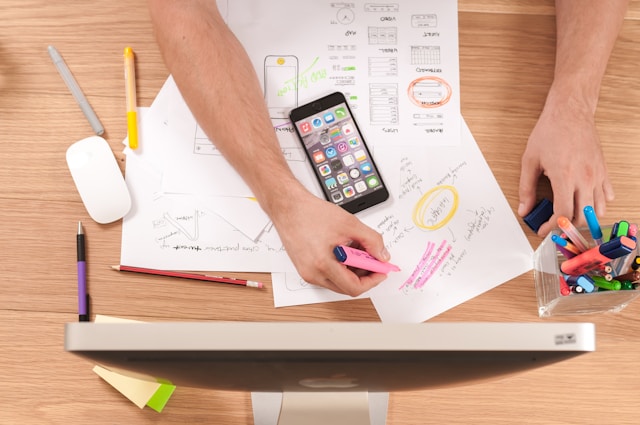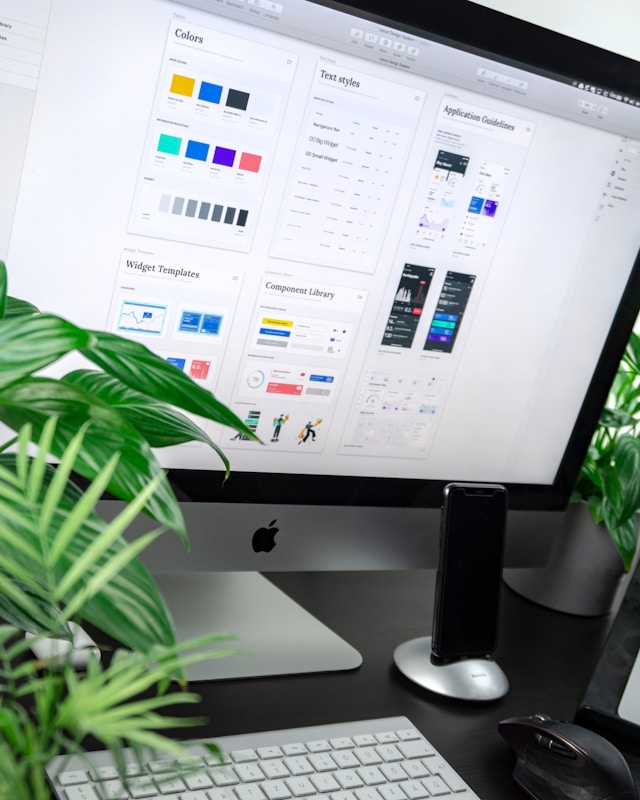The three fields of UX design, UI design, and interaction design connect inextricably. But what is interaction design exactly?
When it comes to digital products, every single interaction is an opportunity to connect with customers. You need to design an experience that delights them every step of the way, with interactions that fuel their desires. Every click, swipe, and press is an interaction, so you have ample opportunity to impress.
Consider this your full guide to interaction design.

What Is Interaction Design?
The first thing to learn is the definition of interaction design. Essentially, it’s about creating digital products that make it as easy as possible for users to achieve their goals.
Also shortened to IxD, interaction design involves defining how users interact with the product. In this way, it overlaps a lot with user experience (UX) and user interfaces (UI).
Interactive design is about creating more meaningful relationships between people and products. Crucially, it involves trying to manage the relationship between the user and the computer to improve it.
So, IxD designers don’t just focus on building visual representations and ensuring the product is usable. Instead, they work to ensure the product communicates its purpose to the user. This way, the user can get the most out of it.
Interaction Design vs. UX and UI
As we’ve already mentioned, there’s a huge overlap between user interaction design and UX/UI. Let’s cover some of the definitions.
- User experience design: Employs design thinking principles and user-centric design to make decisions about how digital products look and feel. UX makes the product functional and enjoyable for the user.
- User interface design: Focuses on the visual design and aesthetics of a product. This includes icons, layouts, fonts, and so on.
- Interaction design: Focuses on the animations, micro-interactions, transitions, and motion-based designs.
While all of these things are important and contribute to the user’s overall experience, they are distinct roles. Interaction designers have a specific job: deciding what happens when a user taps a button, for instance. This focus on human-computer interaction takes the user’s experience to the next level.
It’s useful to think of interaction design as a specialist discipline of UX. However, it’s worth noting that, in some companies, one person is responsible for both things. Small startups, for instance, may hire a UX designer who also creates the interactions.

What Does an Interaction Designer Do?
An interaction designer focuses on delivering great experiences to the end user through their interactions with a product. Day-to-day, this can look different depending on the size of the company, the project at hand, and the production stage.
Generally, an interaction designer should:
- Understand how users think and what their mental models are.
- Understand how to communicate effectively.
- Understand how to anticipate user behavior.
- Keep up-to-date with UX industry trends and design principles.
During the project itself, the interaction designer is responsible for coming up with ideas and creating prototypes. They use software to do this. They’ll also work with stakeholders to gain feedback, and they may run user tests. In the end, they’ll help the development team to bring the ideas to life.
In terms of design strategy, interaction designers use research to consider the goals of the user. When they understand what motivates them and what their desires are, they can come up with ways to facilitate this. Then, they create interactions that will help the user resolve pain points and meet their goals. Ideally, this should be with as little friction as possible.
Following the ideation stage, they create low-fidelity wireframes and, later, high-fidelity prototypes. Just like any other UX role, it’s important to test every step of the way.
The Five Dimensions of Interaction Design
Years ago, interaction design expert Gillian Crampton Smith introduced the idea of four dimensions of interaction design language. Later, Kevin Silver, senior interaction designer at IDEXX Laboratories, added a fifth dimension.
This model essentially explains the role of an interaction designer. With each project, the designer needs to consider all five of these elements or dimensions.
1. Words
Words are what communicate the interaction to the user. Calls to action, button labels, and so on need to be easy to understand. At the same time, there should not be too much information so as not to overwhelm the user. Make all UX writing simple and meaningful.
2. Visual Representations
Visual representations are a key part of any user interface. Any graphical element, including typography, images, and icons, forms part of the communication. Don’t confuse the user with novel or non-sensical icons. Instead, use visuals to supplement the words and communicate information clearly.
3. Physical Objects or Space
Every interaction with a computer takes place via a physical object. For phones, this is the touchscreen; for laptops, it’s the keypad. Even voice-commanded interfaces have a microphone. Interaction designers must consider the physical objects that users interact with to design smart interactions.
Furthermore, they must consider the space where the interaction takes place. For example, if the user is scrolling on their phone on a crowded train, does this limit their interactions?
4. Time
‘Time’ is a more difficult dimension to define. Primarily, this refers to using media that changes with time, such as animation and videos. Both sounds and motion play a key role in giving the user feedback. So, it’s important to consider how this works over time.
Also, interaction designers need to consider how long the user spends interacting with the product. Can they always pick up where they left off? How easy is it for them to enter and exit the product?
5. Behavior
The fifth dimension concerns how users perform their actions. Essentially, this is the culmination of all the previous dimensions and how they affect the interactions. Furthermore, it concerns the emotional response of the users upon using the product. This is something that’s vital to consider for interaction designers so they can plan ahead. How can you elicit a positive emotional response?

Interaction Design Best Practices
With the five dimensions in mind, interaction designers can start to make something that delights the user. However, you can do even more if you keep these best practices in mind in the process.
1. Strategize Carefully
It’s always important to have a design strategy. Make sure you leverage data and research to understand your users, then develop a strategy to target them. Your interaction designs should always feed into this strategy.
2. Ask the Right Questions
You should always be questioning while you create your products. Something that seems logical to you might not be logical to your users. As a result, you need to question everything.
At the same time, it’s important to ask the right questions. Here are some things to consider when designing.
- What commands can a user give to this interface?
- What can a user do to directly interact with this interface? Can they use their hands, a stylus, or a mouse?
- What information can I provide to let the user know what will happen when they perform this action?
- How can the appearance give the user a clue about this function?
- Are there constraints in place to prevent errors?
- What happens if the user makes an error?
- Do the error messages provide a way for the user to fix the problem?
- What feedback will the user receive when they perform the action?
- What’s the response time after initiating an action?
- Are the interactive elements a reasonable size?
- Are you following the relevant standards, such as accessibility standards?
- Are you using familiar formats?
- Are the interactive interface elements obvious and clear?
3. Stay Up-To-Date
Things change quickly in the tech industry, which means UX and interaction standards change all the time. Make sure you stay up-to-date with the latest research and industry standards.
How Cognitive Psychology Fits Into Interaction Design
Interaction design requires a basic understanding of cognitive psychology. In case you’re wondering, some examples include problem-solving, memory, and perception.
This might sound intimidating to some UX designers. However, it doesn’t have to be complicated. Here are some basic cognitive psychology concepts you need to understand.
- The Principle of Least Effort: Users will try to take an action that requires the least amount of energy possible.
- Gestalt principles: The human brain perceives visuals to form familiar structures.
- Hick’s Law: The more choices you give the user, the longer they’ll take to make a decision.
- The Serial Positioning Effect: Human memory is more likely to remember certain items in a list or series. It is more likely to remember the first (primacy effect) and last (recency effect) items but not the middle.
- Von Restorff Effect: In a group of objects, users will remember the one that stands out.
- The Principle of Perpetual Habit: People rely on their habits, which is why universal design patterns are crucial.
- Fitt’s Law: The time required to move to a target is a function between the distance and the target’s size.
- The Principle of Emotional Contagion: Humans mimic or empathize with the emotions and behaviors of others. This includes animations, which is why emojis are important.
It’s important not to cause mental overload in your users. Understanding these concepts will help you.

3 Interaction Design Examples
When delving into any design concept, it’s useful to see examples. Here are three great interaction design examples.
1. iOS Swipe Back
When using an iOS device, users have a few options to return to a previous interface. They can tap a button, or they can swipe from the right edge of the screen. The swipe function means users can conveniently return to a page without having to move to the back button. This creates a more efficient user experience.
2. Pinch To Zoom
Many devices now allow pinch to zoom. It’s a quick way to zoom in on pictures, maps, and a variety of other interfaces. As a convention, this gives the user a convenient and quick way to perform an action. It’s also a logical movement that works on any touchscreen device. Plus, with consistency across devices and apps, it’s easy for users to learn and remember.
3. LinkedIn’s Consistency
LinkedIn has both a website and an app. Users access it across multiple devices, operating systems, and so on. As a result, user interactions can vary wildly.
Nevertheless, LinkedIn has managed to make its user interfaces intuitive across devices. Take the reaction buttons on a post, for instance. On mobile, the user presses and holds to reveal the emojis. On a desktop or a laptop, they hover over the like button with the mouse. These are two different interactions, but both logical in their own way.
Do You Need an Interaction Design Degree To Be a Designer?
You don’t need an interaction design degree to work in this field. In fact, many interaction designers start without a degree.
Some have a degree in a related field, such as graphic design or cognitive psychology. However, others self-teach or take an online course.
If you want to get into interaction design, you need a way to showcase your skills. So, above all else, make sure you build a portfolio to show your talent.
What’s the Average Interaction Designer Salary?
According to Glassdoor, the average interaction designer salary in the US is $108,031. This can vary depending on the size of the company and the scope of your role.
Glassdoor also estimates an additional pay of $7,955 per year. Again, this depends on the type of organization you work for.
Where To Find Interaction Design Jobs
If you’re looking for interaction design jobs, there are plenty of places to start.
- Job boards: Online job boards like Indeed are great places to start. Try to look for UX and interaction design jobs rather than limiting your search.
- UX companies: Seek out industry-specific job boards like the Interaction Design Foundation Careers Page.
- Network: Your connections are important. Network with other professionals in the industry at events and on LinkedIn.
- Your portfolio: Make sure you regularly update your portfolio and push it on social media. You never know who might stumble across it!

Get Useful Interaction Design Ideas
What is interaction design? Hopefully, you know by now! If you want to dive deeper and find more design inspiration, why not learn from proven products?
Page Flows is a helpful resource for finding interaction design ideas. Get started today to access our growing library of user flow recordings and finally stay up-to-date with current design trends.





